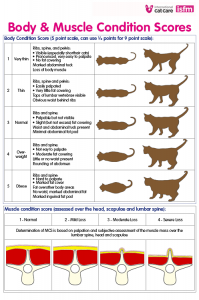Discover if your cat is obese, what the risk factors are, and how to resolve the issue without putting your cat in danger - rapid weight loss can be fatal

Obesity is on the rise even in the cat world, and obese cats are becoming more and more common. The internet is full of very cute photographs of rather fat cats….but being an overweight or obese cat puts your pet at risk of health complications and low energy.
It is estimated that 39% to 52% of cats in the UK are overweight or obese cats. In the cat world, being overweight is defined as being 10% to 19% heavier than the optimal weight for that cat.
As you might expect, obese cats have a shorter life expectancy than their ‘average’ weight counterparts, and a lower quality of life. Cats who are underweight also have a lower life expectancy.
Do you have an obese cat?
Cats come in all different shapes, sizes and breeds. A Siamese cat would be expected to weigh much less than a British shorthair or a Maine Coone, for example, and for a cat of no specific breed there is no guide available as to the average weight that cat should be.
The weight of a cat alone therefore is not very helpful in determining whether your cat is amongst the ranks of the obese cats! It is still a very useful piece of information to have because it can tell you whether your cat is gaining or losing weight before you might otherwise notice the change, and weight loss or gain is an important sign of health issues.
A better way to determine whether your cat is a healthy weight is to use the Body Condition Score. This grades the body condition of a cat from 1-5, with 1 being very thin, 3 being ideal and 5 being obese. In an obese cat the ribs are hard to feel because they are covered by a thick layer of fat, there is a moderate to thick layer of fat covering all the bony prominences and the cat has a pendulous ‘skirt’ or bulge under the abdomen, with no waist.

Health risks for obese cats
-
Diabetes mellitus
-
Lower urinary tract disease
-
Joint stress and aggravation of osteoarthritis
-
Non-allergic skin diseases
-
Hepatic lipidosis
-
Decreased stamina and exercise tolerance
Possible complications for obese cats
-
Increased anaesthetic risk
-
Decreased immune function
-
Dystocia (problems giving birth)
-
Breathing problems
What causes obese cats?
As with humans, obesity is caused by consuming more calories than we expend. Most cats are perfectly able to regulate their calorie intake, and will happily not consume more food than they need for their energy needs. There are certain factors that make some cats less able to do this:
-
Moggy cats are more likely to become obese cats than pedigree cats are,
-
Neutering reduces a cat’s calorie needs by around 20%, so neutered cats are more at risk,
-
Activity levels have a marked impact on calorie expenditure, so inactive cats are more likely to be obese cats,
-
Young cats, under 2 years old, have higher energy needs - cats between 2-10 years old are more likely to be overweight or obese. Cats over 10 years are likely to be underweight,
-
Palatable, high calorie foods lead to weight gain - so feeding delicious treats throughout the day is a risk factor. Dry food has a higher calorie density,
-
Some drugs increase appetite or slow metabolism, causing weight gain, like corticosteroids.
Weight loss for obese cats
For overweight or obese cats it is very dangerous for them to lose weight quickly. Rapid weight loss can cause fatty deposits to build up in there liver which can be fatal. It is therefore important to consult your vet before embarking on any kind of weight loss programme for your cat. Some things that may help your cat lose weight are:
-
Give your cat wet food instead of dry food - in a recent study cats were found to eat fewer calories when given wet food, presumably because the high moisture content in the wet food meant that they full fuller sooner
-
Exercise your cat - get interesting toys for your cat and encourage them to play. Start with 2 short sessions a day and build up from there. Have a look at our best ever cat toys in this article.
-
If your cat is showing no interest in play, try a catnip or a valerian toy. We have found that whilst most of our cats can resist catnip, they all go crazy for valerian! Be patient, a cat that is accustomed to being inactive will take a while to become re-interested in play
-
Weigh your cat regularly to monitor his weight
-
Move your cat's food bowl so he has to walk further to it
-
Use a puzzle feeder - but with caution! If your cat will not use it, make sure you are giving them enough food to avoid rapid weight loss and hepatic lipidosis
-
Feed a high protein, low carbohydrate food. Read our wet cat reviews here
-
Always consult your vet regularly throughout your cat’s weight loss journey or it can be genuinely dangerous
Once your cat has reached a healthy weight, continue to weigh them regularly to ensure their weight is not creeping back on!
Read more….
- What age to neuter your male cat?
- How to introduce a new cat the right way
- The importance of litter tray hygiene
- why all of our kittens are GCCF registered
We are expert breeders of British Shorthair kittens. All of our product reviews are tried and tested by the Bombadillo Kittens!